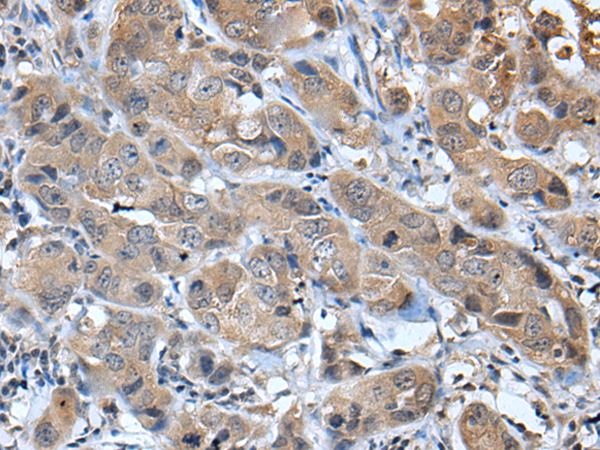
| WB | 咨询技术 | Human,Mouse,Rat |
| IF | 咨询技术 | Human,Mouse,Rat |
| IHC | 1/35-1/200 | Human,Mouse,Rat |
| ICC | 技术咨询 | Human,Mouse,Rat |
| FCM | 咨询技术 | Human,Mouse,Rat |
| Elisa | 1/5000-1/10000 | Human,Mouse,Rat |
| Aliases | SCYB5; ENA-78 |
| Host/Isotype | Rabbit IgG |
| Antibody Type | Primary antibody |
| Storage | Store at 4°C short term. Aliquot and store at -20°C long term. Avoid freeze/thaw cycles. |
| Species Reactivity | Human |
| Immunogen | Synthetic peptide of human CXCL5 |
| Formulation | Purified antibody in PBS with 0.05% sodium azide and 50% glycerol. |
+ +
以下是3篇与CXCL5抗体相关的研究文献概览(内容基于公开研究整理,具体引用请核实原文):
---
1. **文献名称**:*CXCL5 mediates immunosuppression in the tumor microenvironment via PD-L1 expression*
**作者**:Wang D, et al.
**摘要**:该研究通过中和抗体阻断CXCL5.发现其可减少肿瘤微环境中PD-L1的表达,抑制Treg细胞浸润,增强抗肿瘤免疫反应,从而减缓小鼠模型中的结直肠癌进展。
---
2. **文献名称**:*Targeting CXCL5 inhibits hepatocellular carcinoma progression via suppression of neutrophil infiltration*
**作者**:Zhou SL, et al.
**摘要**:研究利用CXCL5特异性抗体阻断CXCL5/CXCR2轴,显著减少肝癌微环境中的中性粒细胞募集,抑制肿瘤血管生成和转移,提示CXCL5抗体在肝癌治疗中的潜力。
---
3. **文献名称**:*CXCL5 contributes to neutrophil recruitment and acute lung injury via TLR4-mediated signaling*
**作者**:Huang WC, et al.
**摘要**:通过小鼠急性肺损伤模型,发现抗CXCL5抗体可阻断TLR4信号通路,减少中性粒细胞向肺组织迁移,缓解炎症反应和组织损伤,为治疗炎症性疾病提供新靶点。
---
如需具体文献来源或补充其他研究,可进一步说明方向(如特定疾病或机制)。
CXCL5 (C-X-C motif chemokine ligand 5), also known as epithelial-derived neutrophil-activating peptide 78 (ENA-78), is a small secreted protein belonging to the CXC chemokine subfamily. It functions as a chemoattractant for neutrophils by binding to the CXCR2 receptor, playing a key role in immune responses, inflammation, and tissue repair. CXCL5 is produced by various cell types, including epithelial cells, macrophages, and tumor cells, and its expression is regulated by inflammatory cytokines (e.g., IL-1β, TNF-α) and pathogen-associated signals.
CXCL5 is implicated in multiple pathological conditions. Elevated levels are observed in cancers (e.g., colorectal, lung, and breast cancers), where it promotes angiogenesis, tumor growth, and metastasis. It also contributes to chronic inflammatory diseases, such as rheumatoid arthritis and inflammatory bowel disease, by sustaining neutrophil infiltration and tissue damage.
CXCL5 antibodies are essential tools for detecting and quantifying CXCL5 in research and diagnostics. They are widely used in techniques like Western blotting, immunohistochemistry, and ELISA to study its expression patterns, cellular localization, and regulatory mechanisms. Therapeutically, neutralizing anti-CXCL5 antibodies are under investigation to block CXCL5-CXCR2 signaling, aiming to suppress inflammation or tumor progression in preclinical models. These antibodies hold potential as targeted therapies, though clinical validation is ongoing. Understanding CXCL5's role and its modulation via antibodies remains a critical focus in immunology and oncology research.
×